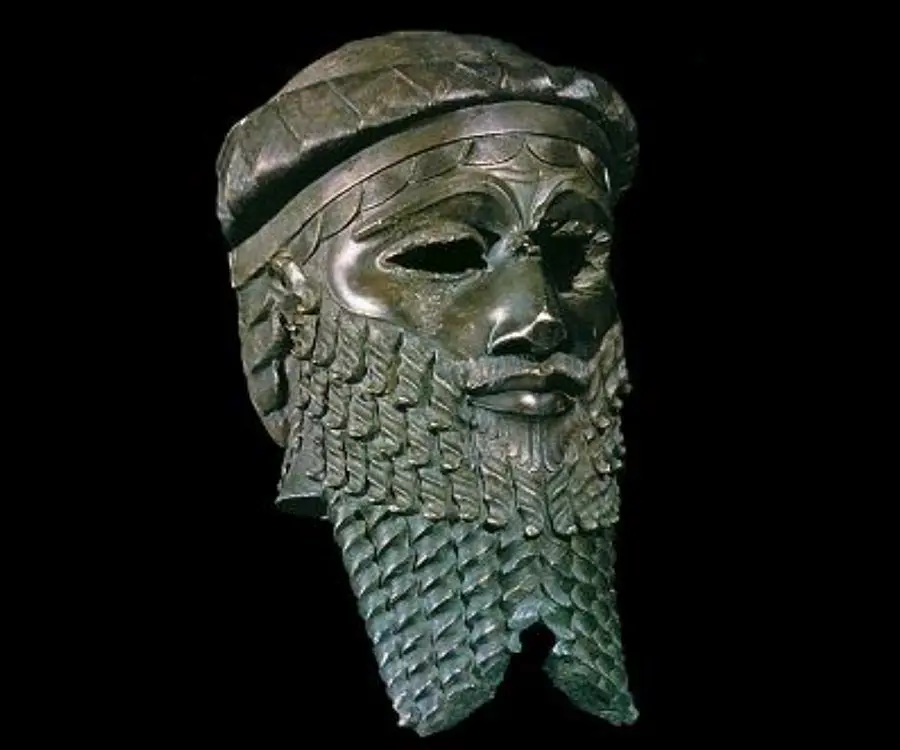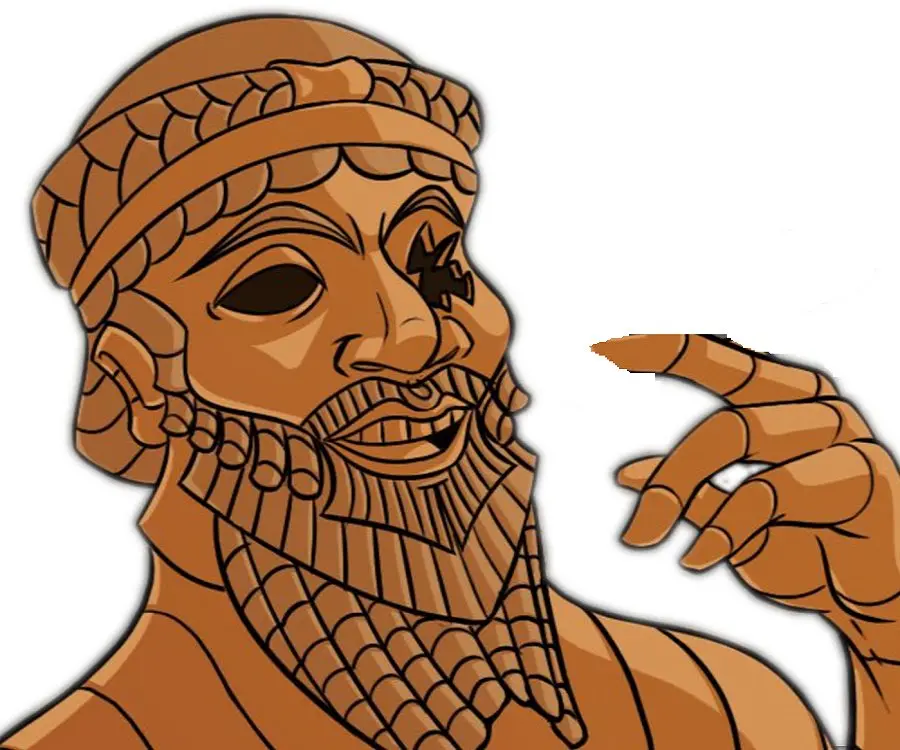
Sargon of Akkad - Emperors, Facts and Life
Sargon of Akkad's Personal Details
Sargon of Akkad, also called ‘Sargon the Great’, ‘Sarru-Kan’ and ‘Shar-Gani-Sharri’, was the founder and first king of the Akkadian Empire
| Information | Detail |
|---|---|
| Birthday | 2340 BC |
| Nationality | Iraqi |
| Famous | Historical Personalities, Emperors & Kings, Emperors, Kings, the First King of the Akkadian Empire |
| Spouses | Tashlultum (m. ?–2279 BC) |
| Childrens | Enheduanna, Manishtushu, Rimush, Shu-Enlil |
| Birth Place | Azupiranu |
| Gender | Male |
| Father | E |
| Mother | Enítum |
| Born in | Azupiranu |
| Famous as | The First King of the Akkadian Empire |
| Died at Age | 56 |
// Famous Kings
Sundiata Keita
Sundiata Keita was the founder of the Mali Empire in West Africa. This biography profiles his childhood, early life, struggles, founding of empire, rule, administration, achievements and also gives some fun facts.
Ashoka
Ashoka was the third emperor of the Mauryan Dynasty and ruled almost the entire Indian subcontinent. This biography profiles his childhood, life, reign, achievements and timeline
Murad IV
Murad IV was one of the mighty Sultans in the history of the Ottoman Empire. This biography profiles his childhood, family, accession, rule, administration and timeline.
Sargon of Akkad's photo
Who is Sargon of Akkad?
Sargon of Akkad, also called ‘Sargon the Great’, ‘Sarru-Kan’ and ‘Shar-Gani-Sharri’, was the founder and first king of the first age-old Semitic-speaking Empire of Mesopotamia known as the Sargonic dynasty. Sargon ruled Mesopotamia from 2334 to 2279 BCE, while his torch bearers of the Akkadian Empire ruled the region for around a century following his demise until the Gutian dynasty displaced the Sargonic dynasty to rule Mesopotamia in the late 3rd millennium BC. Starting from a humble beginning, being born an illegitimate son of a temple priestess who set him afloat in a basket on the Euphrates River to be discovered by a drawer of water to founding an empire ruling entire Mesopotamia, Sargon is regarded as a legend whose marvellous tales are celebrated and revered across the Persian Empire. He was the first monarch who developed a multi-national empire that remained in its political peak between 24th and 22nd centuries BC after he made conquests of the Sumerian city-states during the 24th and 23rd centuries BC. The Neo-Assyrian literature of the 8th to 7th centuries BC reveres him as a legendary figure while the Library of Ashurbanipal preserved tablets comprising fragments of a Sargon Birth Legend.
// Famous Emperors
Sundiata Keita
Sundiata Keita was the founder of the Mali Empire in West Africa. This biography profiles his childhood, early life, struggles, founding of empire, rule, administration, achievements and also gives some fun facts.
Ashoka
Ashoka was the third emperor of the Mauryan Dynasty and ruled almost the entire Indian subcontinent. This biography profiles his childhood, life, reign, achievements and timeline
Murad IV
Murad IV was one of the mighty Sultans in the history of the Ottoman Empire. This biography profiles his childhood, family, accession, rule, administration and timeline.
Childhood & Early Life
According to a 7th century BC Neo-Assyrian text that is claimed to be an autobiography of Sargon, he was born as an illegitimate son of a high priestess who bore him secretly and after his birth adrift him on the Euphrates River in a basket of rushes.
He was found by a drawer of water, Akki who raised him up as his son and later inducted him as his gardener. Sargon never knew who his biological father was. Sumerian Sargon legend however mentions the name as Laʻibum. The legend also mentions that his native place as Azupiranu.
The surviving fragments of the Sumerian-language Sargon legend, that was unearthed in Nippur, an age-old Sumerian city, in 1974, says that he was inducted as cup-bearer of Ur-Zababa, the second king of the 4th Dynasty of Kish, by the latter, however the reasons remained unknown. The legend also chronicles the way Sargon attained power.
Even though Sargon is counted among the most revered historic figures, his legends remained unknown to the world at large until the Legend of Sargon was published by archaeologist Sir Henry Rawlinson in 1870 CE. Rawlinson discovered it in 1867 CE in the library of Ashurbanipal during an excavation in Nineveh.
Rise to Power, Conquests & Reign
According to Sumerian legend when Lugal-zage-si of Umma started conquering the city-states of the Sumer region and after conquering Uruk he resolved to approach Kish, Ur-Zababa became anxious.
Bauer mentions "Ur-Zababa, learning that the army of the conqueror was approaching his city, grew so frightened that he ‘sprinkled his legs' . For reasons unknown Ur-Zababa somehow lost trust on Sargon and send him to Lugal-zage-si with a message on a clay tablet asking the latter to kill Sargon.
Lugal-zage-si however did not follow such advise and instead took Sargon in his side to conquer Kish while Ur-Zababa escaped for life. Although what followed next is not clear due to various versions surrounding Sargon’s legends, the two historic figures became rivals soon.
In no time Sargon conquered Uruk and his conquest of Sumer not only marked Lugal-zage-si as the last Sumerian king but also the rise of the Akkadian Empire with Sargon proclaiming himself as the king of Kish.
Inscription of a tablet from the Old Babylonian period that was discovered during a 1890s expedition at Nippur reveals that Sargon referred himself as “Sargon, king of Akkad, overseer of Inanna, king of Kish, anointed of Anu, king of the land [Mesopotamia], governor (ensi) of Enlil".
According to the middle chronology timeline of the Ancient Near East, he reigned from c. 2334 – c. 2279 BC.
It is not clear whether he built the city of Akkad, also called Akkade and Agade, on the banks of the Euphrates River or remodeled it. The city not only remained capital of the Akkadian Empire, but also an effective political force in Mesopotamia for around one and a half century.
After Kish he conquered much of Mesopotamia including Ur and E-Ninmar; conquered and destroyed Umma; took over territories of Upper Mesopotamia and the Levant inclusive of Ibla, Yarmiti and Mari.
He invaded Syria and Canaan four times and collected tribute from Elam and Mari. His conquests saw him ruling from the Mediterranean to the Persian Gulf that is from the “upper sea” to the “lower sea”. Sargon expanded his reign beyond Mesopotamia and according to a tablet he remained victorious in 34 battles.
The unification of city-states of Akkad and Sumer under his reign gradually saw rise of political power and economic growth of Mesopotamia.
His reign was marked with influence and development of trade that extended from copper of Magan, cedars of Lebanon to silver mines of Anatolia. His trade initiatives saw him sending ships to faraway places including in India, while ships from places like Magan, Meluhha and Dilmun anchored in Akkad.
The age-old Mesopotamian epic tale ‘šar tamḫāri’ or ‘King of Battle’ narrates his campaign against King Nur-Daggal and the latter’s city of Purušḫanda in the Anatolian highlands in pursuit of protecting his merchants.
According to some old historiographic texts (ABC 19, 20), Sargon reconstructed the Babylon (Bab-ilu) city in front of Akkad.
His rule saw standardization of East Semitic language which was adapted to apply with the cuneiform writing system that was earlier used in the non-Semitic Sumerian language. It became renowned as the Akkadian language, the earliest attested Semitic language.
He faced wrath of famine as also revolts from all the lands during the later years of his reign. He however thrived in defeating such revolts in battles including defeating a coalition army under leadership of King of Awan. The later Babylonian historiographical text ‘Chronicle of Early Kings’ gives a narrative of such revolts.
He was succeeded by his son Rimush who reigned from c. 2279 BC to 2270 BC and following the latter’s death another son of Sargon, Manishtushu, succeeded the throne.
The successors of the Sargonic dynasty of the Akkadian Empire ruled Mesopotamia until they were displaced by the Gutian dynasty that took over in the late 3rd millennium BC.
For around two thousand years after Sargon’s demise, he was considered a model by other kings of Mesopotamia. The Mesopotamia based Assyrian and Babylonian rulers regarded themselves as heirs of his kingdom.
Naram-Sin, grandson of Sargon and son of Manishtushu emerged as one of the most noted kings of the Akkadian dynasty who became the first Mesopotamian king to claim the epithet “God of Akkad” as also among the first to earn the title "King of the Four Quarters, King of the Universe".
In 1931, a bronze head of an Akkadian king was unearthed that is considered either to be of Sargon or that of Naram-Sin.
Personal Life & Legacy
From an inscription found in a single shard of an alabaster vase it is assumed that Tashlultum was a wife of Sargon who became the queen of Akkad. She gave birth to his children including Rimush, Ilaba'is-takal, Manishtushu, Enheduanna and Shu-Enlil.
All through his life Sargon held the Sumerian deities with great reverence especially his patroness Inanna (Ishtar) and the warrior god of Kish, Zababa.
His daughter Enheduanna became a High Priestess of Nanna (Sin), the moon god, in the Sumerian city-state of Ur. Her rich body of literary work inclusive of hymns renowned as "Sumerian Temple Hymns" as also many personal devotions to the goddess Inanna were used for centuries.
He died in c. 2284 BC (MC).
Sargon of Akkad biography timelines
- // 1867 To 1870Even though Sargon is counted among the most revered historic figures, his legends remained unknown to the world at large until the Legend of Sargon was published by archaeologist Sir Henry Rawlinson in 1870 CE. Rawlinson discovered it in 1867 CE in the library of Ashurbanipal during an excavation in Nineveh.
- // 1931In 1931, a bronze head of an Akkadian king was unearthed that is considered either to be of Sargon or that of Naram-Sin.
- // 1974The surviving fragments of the Sumerian-language Sargon legend, that was unearthed in Nippur, an age-old Sumerian city, in 1974, says that he was inducted as cup-bearer of Ur-Zababa, the second king of the 4th Dynasty of Kish, by the latter, however the reasons remained unknown. The legend also chronicles the way Sargon attained power.
// Famous Emperors & Kings
Sundiata Keita
Sundiata Keita was the founder of the Mali Empire in West Africa. This biography profiles his childhood, early life, struggles, founding of empire, rule, administration, achievements and also gives some fun facts.
Ashoka
Ashoka was the third emperor of the Mauryan Dynasty and ruled almost the entire Indian subcontinent. This biography profiles his childhood, life, reign, achievements and timeline
Murad IV
Murad IV was one of the mighty Sultans in the history of the Ottoman Empire. This biography profiles his childhood, family, accession, rule, administration and timeline.
Xerxes I
Xerxes I (Xerxes the Great) was the fourth and the most famous king of the Archaemenid dynasty of Persia. This biography profiles his childhood, family, personal life, life history, achievements, campaigns, administration, death and other facts.
Abdullah of Saudi Arabia
Abdullah bin Abdulaziz Al Saud was the King of Saudi Arabia from 2005 to 2015 and the third wealthiest head of state in the world. Find more facts about his life, childhood and timeline.
Napoleon Bonaparte
Napoleon Bonaparte was a French military and political leader who rose to prominence during the French Revolution. This biography provides detailed information about his childhood, life, career, achievements & timeline.
Sargon of Akkad's FAQ
When was Sargon of Akkad died?
Sargon of Akkad was died at 2020-04-14
Which age was Sargon of Akkad died?
Sargon of Akkad was died at age 56
Where is Sargon of Akkad's birth place?
Sargon of Akkad was born in Azupiranu
What is Sargon of Akkad nationalities?
Sargon of Akkad's nationalities is Iraqi
Who is Sargon of Akkad spouses?
Sargon of Akkad's spouses is Tashlultum (m. ?–2279 BC)
Who is Sargon of Akkad childrens?
Sargon of Akkad's childrens is Enheduanna, Manishtushu, Rimush, Shu-Enlil
Who is Sargon of Akkad's father?
Sargon of Akkad's father is E
Who is Sargon of Akkad's mother?
Sargon of Akkad's mother is Enítum
How famous is Sargon of Akkad?
Sargon of Akkad is famouse as The First King of the Akkadian Empire








